| The Coinage of the English Civil War 1642-1651
By Keven D
THE IRISH REBELLION
The English Civil War started with The Irish Rebellion of 1641, began as an attempted coup d'état by Irish Catholic gentry, who tried to seize control of the English administration in Ireland to force concessions for Catholics. The coup failed and the rebellion developed into an ethnic conflict between the Gaelic Irish and old English Catholics on one side, and both ethnically English Protestants and Scottish/Presbyterian planters on the other. This began a conflict known as the Irish Confederate Wars.
The rising was sparked by Catholic fears of an impending invasion of Ireland by anti-Catholic forces of the English Long Parliament and the Scottish Covenanters, who were defying the authority of King Charles I (king of England, Scotland, and Ireland). In turn, the rebels' suspected association with Charles helped start the English Civil War. The English and Scottish Parliaments refused to raise an army to put down the rebellion unless it was under their command rather than the King's.
The Irish rebellion broke out in October 1641 and was followed by several months of violent chaos before the Irish Catholic upper classes and clergy formed the Catholic Confederation in the summer of 1642. The Confederation became a de facto government of most of Ireland, free from the control of the English administration and loosely aligned with the Royalist side in the Wars of the Three Kingdoms. The subsequent Irish Confederate Wars continued in Ireland until the 1650s, when Oliver Cromwell's New Model Army decisively defeated the Irish Catholics and Royalists, and re-conquered the country. The 1641 Irish Rebellion is seen as a key event in the mid-17th century collapse of the Stuart monarchy.
The roots of the 1641 rebellion lay in the failure of the English State in Ireland to assimilate the native Irish elite in the wake of the Elizabethan conquest and plantation of the country. The pre-Elizabethan Irish population is usually divided into the "Old (or Gaelic) Irish", and the Old English, or descendants of medieval Norman settlers. These groups were historically antagonistic, with English settled areas such as the Pale around Dublin, south Wexford, and other walled towns being fortified against the rural Gaelic clans.
The Rebellion brought about the need for emergency money in Ireland to pay for an army and resources.
"INCHIQUIN MONEY"
These pieces were cut out of flattened silver plate, issued in 1642.

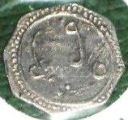
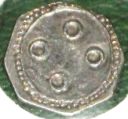
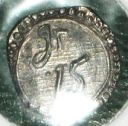
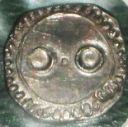

Issue of 1642................................................................Annulet Issue of 1642.............................................................Issue of 1643 "Dublin" Money
Click on image for a larger version
"ORMONDE MONEY"


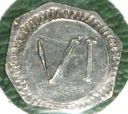
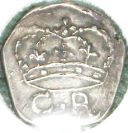
Issue of 1643 - 1644
LOCAL ISSUES OF THE SOUTHERN "CITIES OF REFUGE"
Bandon (Bridge)
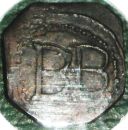
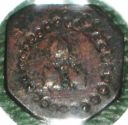
Farthing....O: B.B..........R: 3 castles
Corke
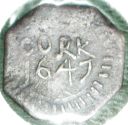
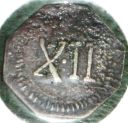

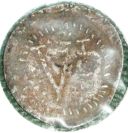
Cork Shilling, Octagonal, R: X.II and Cork 6 pence, R: VI (over stamp on Elizabeth 6d)
Kinsale
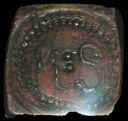
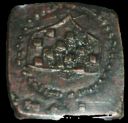
Farthing
O: K.S (in circle of pellets) and R: Chequered Shield
Click on image for a larger version
THE ENGLISH CIVIL WAR
The English Civil War (1642-1651) was a series of armed conflicts and political maneuvering between Parliamentarians ("Roundheads") and Royalists ("Cavaliers") over, principally, the manner of England's government. The first (1642-1646) and second (1648-1649) wars pitted the supporters of King Charles I against the supporters of the Long Parliament, while the third (1649-1651) saw fighting between supporters of King Charles II and supporters of the Rump Parliament. The war ended with the Parliamentarian victory at the Battle of Worcester on 3 September 1651.
The overall outcome of the war was threefold: the trial and execution of Charles I (1649); the exile of his son, Charles II (1651); and the replacement of English monarchy with, at first, the Commonwealth of England (1649-1653) and then the Protectorate under the personal rule of Oliver Cromwell (1653-1658) and subsequently his son Richard (1658-1659). The monopoly of the Church of England on Christian worship in England ended with the victors consolidating the established Protestant Ascendancy in Ireland. Constitutionally, the wars established the precedent that an English monarch cannot govern without Parliament's consent, although the idea of Parliament as the ruling power of England was only legally established as part of the Glorious Revolution in 1688
COINS MINTED DURING THE CIVIL WAR
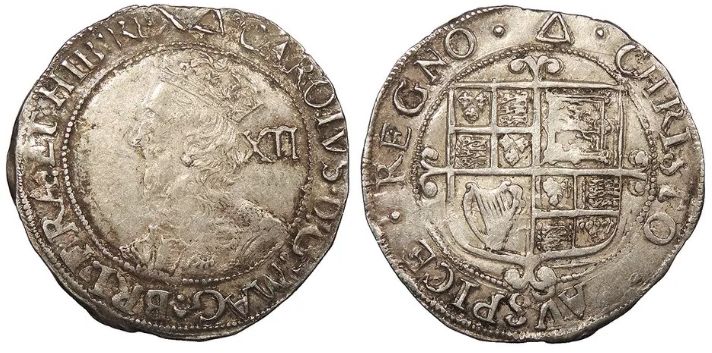
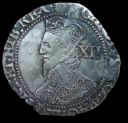
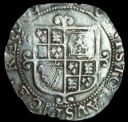
1 Shilling (Tower Mint under Charles 1941-1943) and 1 Shilling (Tower Mint under Parliament 1945-1946)
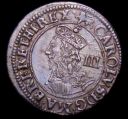
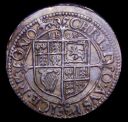
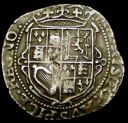
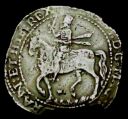
3 Pence (York Mint 1643-1644, mm. Lion) and 2 ½ shilling (Half Crown) Worchester Mint 1944-45

6 Pence (Exeter, mm. Rose, 1644)
Click on image for a larger version
THE CITIES UNDER SIEGE
These coins were usually cut out of flattened silver plates.
CARLISLE
1644 - 1645

Shilling
NEWARK
1645 - 1646
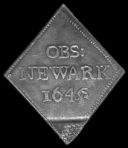
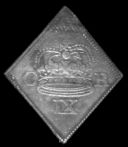
9 Pence
PONTEFRACT
June 1648 - March 1649
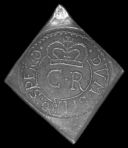
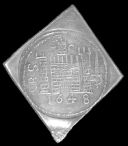
2 shillingSCARBOROUGH
July 1644 - July 1645
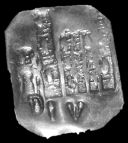
4 Pence (groat)
Type II
(small castle with gateway No SC, value punched on flan)
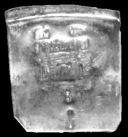

1 Shilling.........................2 Shilling
(note: rim of plate)....(cut from base of plate)
Type III
(castle gateway with 2 turrets,value punched below)
Click on image for a larger version
NEW COMMONWEALTH COINAGE (PARLIAMENT)
The coins that were struck between 1649 & 1659, during the term of the Commonwealth have inscriptions in English instead of Latin as a truer expression of Protestantism. St George's cross and the Irish harp take the place of the Royal arms. The silver ½ penny was issued for the last time. Coins with mm. Some were struck during the protectorship of Oliver Cromwell, and those with mm. Anchor are struck during the protectorship of Richard Cromwell (son).
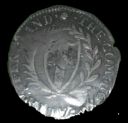

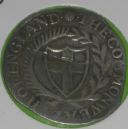
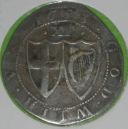
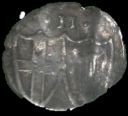
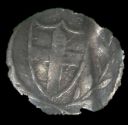
2 ½ Shilling (Half Crown), 1656............................1 shilling, 1935.......................................2 pence (no date)
Click on image for a larger version
OLIVER CROMWELL
Oliver Cromwell (25 April 1599 - 3 September 1658) was an English military and political leader. He served as Lord Protector of the Commonwealth of England, Scotland, and Ireland from 1653 until his death, acting simultaneously as head of state and head of government of the new republic. Cromwell had no formal training in military tactics, and followed the common practice of ranging his cavalry in three ranks and pressing forward, relying on impact rather than firepower. His strengths were an instinctive ability to lead and train his men, and his moral authority. In a war fought mostly by amateurs, these strengths were significant and are likely to have contributed to the discipline of his cavalry.
Cromwell introduced close-order cavalry formations, with troopers riding knee to knee; this was an innovation in England at the time, and was a major factor in his success. He kept his troops close together following skirmishes where they had gained superiority, rather than allowing them to chase opponents off the battlefield. This facilitated further engagements in short order, which allowed greater intensity and quick reaction to battle developments. This style of command was decisive at both Marston Moor and Naseby
After the execution of King Charles 1st, a republic was declared, known as the "Commonwealth of England". The "Rump Parliament" exercised both executive and legislative powers, with a smaller Council of State also having some executive functions. Cromwell remained a member of the "Rump" and was appointed a member of the Council. In the early months after the execution of Charles I, Cromwell tried but failed to unite the original group of "Royal Independents" centred around St John and Saye and Sele, which had fractured during 1648. Cromwell had been connected to this group since before the outbreak of civil war in 1642 and had been closely associated with them during the 1640s.
However, only St John was persuaded to retain his seat in Parliament. The Royalists, meanwhile, had regrouped in Ireland, having signed a treaty with the Irish known as "Confederate Catholics". In March, Cromwell was chosen by the Rump to command a campaign against them. Preparations for an invasion of Ireland occupied Cromwell in the subsequent months. In the latter part of the 1640s, Cromwell came across political dissidence in his "New Model Army".
The "Leveller" or "Agitator" movement was a political movement that emphasised popular sovereignty, extended suffrage, equality before the law, and religious tolerance. These sentiments were expressed in the manifesto "Agreement of the People" in 1647. Cromwell and the rest of the "Grandees" disagreed with these sentiments in that they gave too much freedom to the people; they believed that the vote should only extend to the landowners. In the "Putney Debates" of 1647, the two groups debated these topics in hopes of forming a new constitution for England. There were rebellions and mutinies following the debates, and in 1649, the Bishopsgate mutiny resulted in the execution of Leveller Robert Lockyer by firing squad. The next month, the Banbury mutiny occurred with similar results. Cromwell led the charge in quelling these rebellions. After quelling Leveller mutinies within the English army at Andover and Burford in May, Cromwell departed for Ireland from Bristol at the end of July.
COINAGE THAT WAS INTENDED FOR CIRCULATION
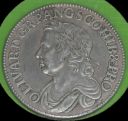

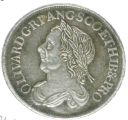
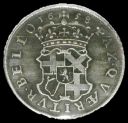
5 Shilling (Crown) 1958 ............................ 2 ½ shilling (Half Crown) 1658
Click on image for a larger version

